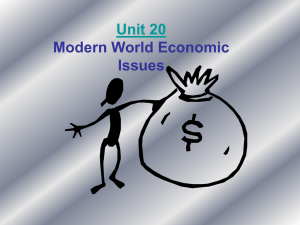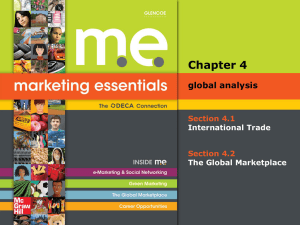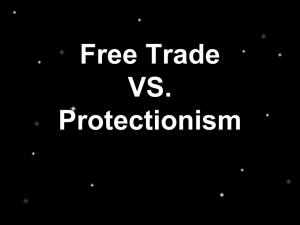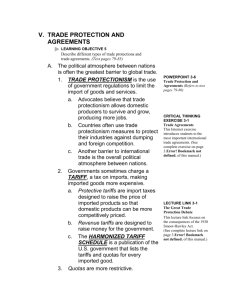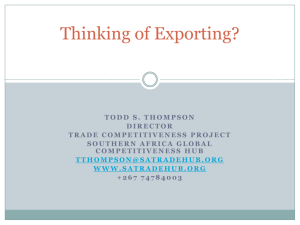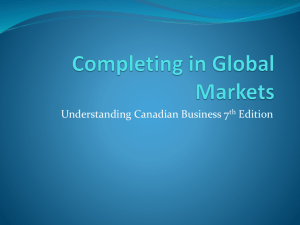Benefits of International Business
advertisement
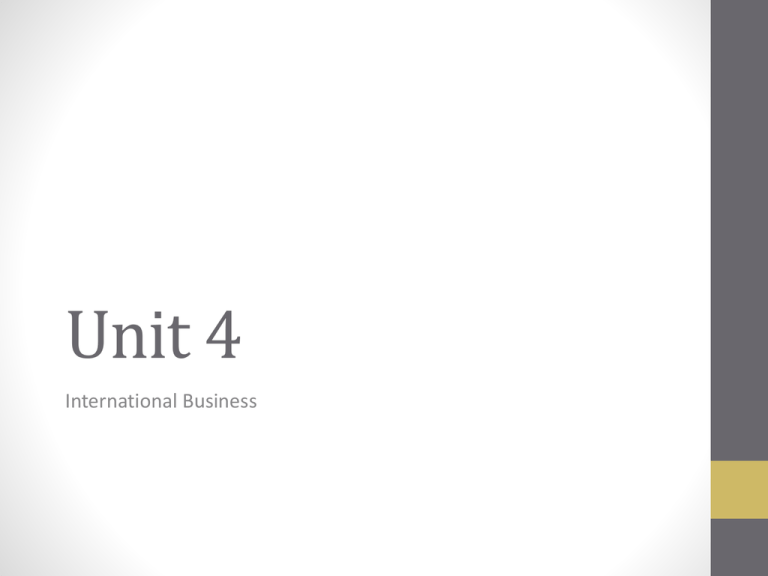
Unit 4 International Business Chapter 4 INTERNATIONAL BUSINESS Essential Questions • • • • • What is International business? What are the benefits of International business? What are the Five P’s of International business? What are the social costs of International business? How does the Canadian government protect domestic businesses and consumers in the international market? • What is meant by ‘balance of trade’? • Who are included in each of the following trade agreements: the WTO, G8, APEC, NAFTA and EU? What is International Business? • A domestic transaction is the selling of items produced in the same country. • An international transaction is the selling of items produced in other countries. These items contribute to the global economy. • Benefits of International Business • • • • • Access to new markets Cheaper labor Increased quality of goods Increased quantity of goods Access to resources What is International Business? • The Benefits of International Business • Access to Markets • By trading abroad, Canadian businesses can gain access to markets that are much larger than those at home. • Customers in other parts of the world have different needs and wants. • A global product is a standardized item that is offered in the same format in all countries. • Cheaper Labor • Lower prices as a result of cheap labor in other countries is the number one reason why consumers buy items made in different parts of the world. What is International Business? • Increased Quality of Goods • International business can help producers improve the quality of the products they sell. • Increased Quantity • As long as a product has international appeal, so does the potential for increased sales. • Access to Resources • Connections to international markets provides business with increased access to the three types of economic resources: • Natural • Human • Capital What is International Business? • All countries benefit when business produce specialized goods and services that appeal to consumers. • International businesses provides increased markets for business and offers them a broader choice of products, services, and prices for its consumers. • The Five Ps of International Business 1. 2. 3. 4. 5. Product Price Proximity Preference Promotion What is International Business? • What are the 5 Ps of International Business? • Product • A country’s resources determines what goods and services it produces. • Price • The cost of producing goods and services varies from country to country. • Sometimes it may be more profitable for Canadian businesses to produce products overseas and then ship them here to sell to consumers. • Lower foreign wages, taxes, and material costs make it cheaper to produce products abroad rather than domestically. What is International Business? • What are the 5 Ps of International Business? • Proximity • It may be advantageous and profitable for some businesses to sell products and services to consumers near a neighbouring country’s border rather than to its domestic customers. • For example, 80% of the Canadian population lives within 170 km of the American border. • Therefore, many Canadian businesses trade extensively with Americans. • The reverse is also true: Americans market many of their goods and services to Canada. What is International Business? • What are the 5 Ps of International Business? • Preference • Consumers often purchase foreign goods and services based on their reputation and specialization, even though similar products are produced domestically. • Two examples are: Swiss Watches, and Belgium chocolates • Promotion • Technology, especially the internet, makes it easy for businesses to promote their products and services automatically. What is International Business? • The social costs of International trade • The social costs often associated with international trade include offshore outsourcing, human rights violations, and environmental degradation. • Offshore Outsourcing • Offshore outsourcing occurs when business decide to produce all or part of their goods in countries where labor costs are lower. • Some advantages include proximity to natural resources, more efficient technology, indigenous innovation, and favorable tax structures. • However, offshore outsourcing faces potential changes in the future as companies may turn to transnational corporations that operate in several countries to produce their goods and services. What is International Business? • Human Rights Violations • Some workers in poor countries face labour exploitation, such as physical and sexual abuses, forced confinement, non-payment of wages, denial of food and health care, and excessive working hours. • Child Labor – the regular employment of boys and girls under the age of 16 – is commonly practices in poor countries where the workforce is often exploited. • Environmental Degradation • Sustainable development is the process of developing land, cities, businesses, and communities that meet the needs of the present generation without compromising those of the future. • Environmental degradation is the consumption of natural resources, such as trees, water, earth, habitat, and air, faster than nature can replenish them. What is International Business? • Barriers to International Business • The Canadian government uses barriers, often referred to as roadblocks, to help protect domestic businesses and consumers. • Tariffs • Tariffs, also called customs duties, are a form of tax on certain types of imports. • Finished imported goods include tariffs, which increase their prices. • Canadian products do not carry such tariffs, and therefore, may be sold at lower prices. • In an effort to protect their domestic industries, countries put up tariff barriers by increasing the cost of imported goods. What is International Business? • Non-Tarif Barriers • Non-Tarif barriers are controls or standards for the quality of imported goods set so high that foreign competitors cannot enter the market. • Costs of Importing and Exporting • The price of a product or service must take the landed costs into consideration. • The landed cost is the actual cost of an imported purchased item, composed of the vendor cost, transportation charges, duties, taxes, broker feeds, and any other chargers. What is International Business? • Excise Taxes • An excise tax is a tax on the manufacture, sale, or consumption of a particular product within a country. • Currency Fluctuations • Since currency rates fluctuate on a daily basis, an international purchase made on the day may cost less or more than another purchase made on the following day. • Shifting currency exchange rates vary as the economic strength of the two countries change on a daily or weekly basis. Flows of Goods and Services • Imports, such as raw materials, processed material, semifinished goods, and manufactured products, flow into Canada, goods and materials also leave Canada as exports. • Balance of Trade • To maintain a healthy balance of trade, countries try to import the same total value of products that they export. • An imbalance of the two results in the following: • A trade deficit in which a country pays more for imports than it earns from imports. • A trade surplus in which a country earns more from exports than it pays for in imports. Flows of Goods and Services • Imports • Five ways to Offset the Risk of Importing 1. 2. 3. 4. 5. Measure consumer interest. Use care when selecting foreign suppliers. Learn about a foreign partner’s culture. Carefully scrutinize the purchase agreement and then sign it. Check goods for quantity and quality upon arrival • Exports • Direct exporting is exporting a product directly to an importer without using an intermediary. • Indirect exporting is exporting a product to an intermediary who then conveys the product to the importer. • Larger established companies usually use direct exporting while newer ones utilize indirect exporting. Flows of Goods and Services • Offsetting Risks • Exporters reduce risks by planning carefully. • As part of their plan, they conduct market research to ensure that there are consumers for their goods and services. • Canada’s Major Trading Partners • Canada’s number one trade partner is the United States. • Three major reasons for trading with the United States include: 1. Low cost of shipping due to proximity 2. Similar cultures (languages, interests, product interests etc.) 3. A American market is much larger than the domestic one. International Trade Agreements • Two main advantages of reducing trade barriers 1. 2. Domestic business can sell their products abroad at lower prices since duties are not added. Consumers have access to new foreign products that may result in lower costs and quality improvement of domestic products. • Trade agreements between countries allow goods and services to flow more freely across boarders. • World Trade Organization (WTO) • In 1947. the General Agreement on Tariffs and Trade (GATT) was signed by 23 nations who were allies in World War II. • The trade agreement came into effect in 1948. • Eventually, GATT grew to 115 member states before it was replaced by the World Trade Organization (WTO) in 1995. • Today the WTO is the principle international organization that deals with rules of trade between nations. International Trade Agreements • North American Free Trade Agreement (NAFTA) • Canada-U.S. Free Trade Agreement (FTA) came into effect in January 1989. • In 1994, Mexico, the United States, and Canada formed the North American Free Trade Agreement (NAFTA). • Other Free Trade Agreements • Bilateral agreements involve Canada and one other country or group. • A trading bloc is a group of countries that share trade interests. • Group of Eight (G8) • The Group of Eight (G8) is an association of the world’s most powerful industrialized democracies. • Meeting annually, the G* deals with economic and political issues facing their own countries and those of the larger international community. • Topics discussed include energy, employment, the environment, human rights, and arms control. The Future of International Trade • The Asia-Pacific Economic Corporation (APEC) is an economic development organization formed in 1889. • The Asia-Pacific market is the fastest growing trade group in the world. • European Union (EU) • In 1993, the European Union (EU) united 12 member states into a single market. • Today the EU has 15 members and a population of more than 370 million people. • Evolution of NAFTA • If NAFTA becomes a single market, it could result in workers from the US, Canada, and Mexico moving freely between countries. The Future of International Trade • Impact of Cultural Differences • International trade depends on our response to and acceptance of cultural differences. • Culture is defined as that which seems normal to us, or any given country’s way of life, beliefs, and customs. • Dealing with People • Conducting successful business in foreign countries involves learning what is important to their populations as well as its cultural nuances. • Punctuality • The value of punctuality depends on the cultures: some cultures value timeliness, some do not. • It is important to understand this before visiting foreign countries. • Other characteristics to recognize are working at an acceptable pace, having good manners, and learning to avoid waits and disappointments. • Greetings • Greetings someone can leave an important first impression. The Future of International Trade • Nonverbal Communication Signals • Nonverbal signals can convey more than words do. • Good Manners • In Canada, the United States, and some European countries, business is completed at a quick and efficient pace. • Most other countries prefer to get to know people before any business is done. • Decision Making • In North America, decision making is typically top-down. • In other cultures, decisions are made from the bottom up. • Global Dependency • Global dependency exists when customers in one country demand items that are created in another. International Business BRAND NAMES LOST IN TRANSLATIONS Coming to a store near you…. This extremely popular soda is bottled in Ghana, means “very good Cola,” but that’s not most tourists’ first impressions. Coming to a store near you…. The Lumia by Nokia Nokia’s new smartphone translates into the Spanish slang word for ‘prostitute, which you might say is very unfortunate. Coming to a store near you…. In Iran, where this detergent is manufactured, the name of this product means “snow.” Outside of Iran, where this detergent is sold, it calls forth something rather less pristine and redolent. Coming to a store near you…. In Poland, where this candy bar is made, the name translates to “lucky bar.” Coming to a store near you…. In Ghana, whoever decided to market these popular hot black peppers using their local name was not giving those who consume them a fair warning.
